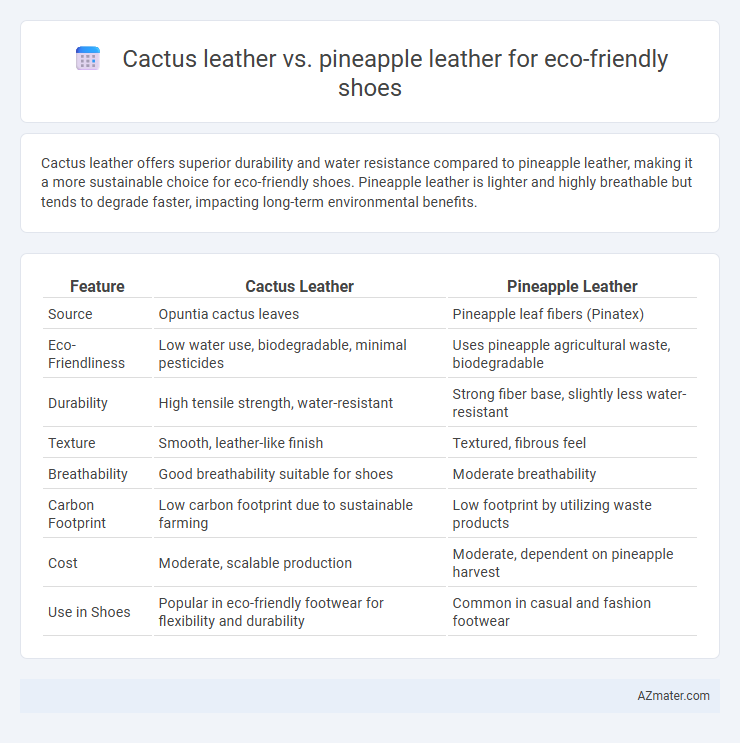Cactus leather offers superior durability and water resistance compared to pineapple leather, making it a more sustainable choice for eco-friendly shoes. Pineapple leather is lighter and highly breathable but tends to degrade faster, impacting long-term environmental benefits.
Table of Comparison
| Feature | Cactus Leather | Pineapple Leather |
|---|---|---|
| Source | Opuntia cactus leaves | Pineapple leaf fibers (Pinatex) |
| Eco-Friendliness | Low water use, biodegradable, minimal pesticides | Uses pineapple agricultural waste, biodegradable |
| Durability | High tensile strength, water-resistant | Strong fiber base, slightly less water-resistant |
| Texture | Smooth, leather-like finish | Textured, fibrous feel |
| Breathability | Good breathability suitable for shoes | Moderate breathability |
| Carbon Footprint | Low carbon footprint due to sustainable farming | Low footprint by utilizing waste products |
| Cost | Moderate, scalable production | Moderate, dependent on pineapple harvest |
| Use in Shoes | Popular in eco-friendly footwear for flexibility and durability | Common in casual and fashion footwear |
Introduction to Eco-Friendly Shoe Materials
Cactus leather and pineapple leather represent innovative, sustainable alternatives to traditional animal leather in eco-friendly shoe manufacturing. Both materials utilize renewable plant resources, with cactus leather made from mature cactus leaves and pineapple leather derived from pineapple leaf fibers, significantly reducing environmental impact through waste valorization. These bio-based leathers offer durability, breathability, and biodegradability, aligning with increasing consumer demand for cruelty-free and low-carbon footprint footwear options.
What is Cactus Leather?
Cactus leather is a sustainable, vegan material made from mature leaves of the prickly pear cactus, which are harvested without harming the plant. This eco-friendly leather alternative requires minimal water and pesticides compared to traditional leather production, significantly reducing its environmental footprint. Its durability and natural texture make it an ideal choice for eco-conscious shoe manufacturers aiming to combine style with sustainability.
What is Pineapple Leather?
Pineapple leather, known as Pinatex, is an innovative eco-friendly material made from pineapple leaf fibers, offering a sustainable alternative to traditional leather. It utilizes agricultural waste, reducing environmental impact while providing a durable and biodegradable option for shoe manufacturing. Compared to cactus leather, pineapple leather boasts a unique texture and breathability, making it increasingly popular in the eco-conscious footwear industry.
Sustainability of Cactus Leather
Cactus leather demonstrates exceptional sustainability through its low water consumption and minimal chemical use compared to traditional leather alternatives. Its production involves harvesting mature cactus pads without harming the plant, enabling natural regeneration and reducing environmental impact. This eco-friendly process positions cactus leather as a superior choice for sustainable shoe manufacturing over pineapple leather, which often requires intensive processing and resource use.
Sustainability of Pineapple Leather
Pineapple leather, derived from the fibers of pineapple leaves, offers a highly sustainable alternative for eco-friendly shoes due to its use of agricultural waste, reducing reliance on animal products and synthetic materials. It boasts a low water footprint and requires minimal chemical processing, significantly lowering its environmental impact compared to cactus leather. The biodegradable nature of pineapple leather ensures reduced landfill waste, aligning with circular economy principles in sustainable fashion.
Durability and Performance in Footwear
Cactus leather offers high durability with a resilient, water-resistant surface ideal for long-lasting eco-friendly shoes, maintaining shape and wear resistance over time. Pineapple leather, derived from Pinatex, provides moderate durability with a softer texture, excelling in breathability and lightweight performance but may show faster wear in high-friction areas. Both materials contribute to sustainable footwear by reducing reliance on animal leather, with cactus leather often preferred for rugged uses and pineapple leather favored for comfort and flexibility.
Environmental Impact Comparison
Cactus leather requires significantly less water and land resources compared to pineapple leather, contributing to a lower environmental footprint in eco-friendly shoe production. Pineapple leather, derived from pineapple leaf fibers, offers biodegradable properties but typically involves more intensive processing chemicals, increasing its environmental impact. Both materials excel over traditional leather by reducing greenhouse gas emissions and promoting sustainable agriculture, yet cactus leather's minimal resource demands position it as the greener alternative for sustainable footwear.
Visual and Aesthetic Differences
Cactus leather boasts a smooth texture with natural grain patterns, offering a matte finish that mimics traditional leather, making it visually appealing for classic and high-end eco-friendly shoes. Pineapple leather, derived from Pinatex, features a more fibrous surface with visible pineapple leaf fibers, providing a unique, textured aesthetic that appeals to sustainable fashion seekers. Both materials exhibit distinct visual cues that influence the shoe's overall design, with cactus leather leaning towards subtle sophistication and pineapple leather embracing a raw, organic look.
Cost and Market Availability
Cactus leather offers a competitive price point with moderate production costs, making it an increasingly popular choice for eco-friendly shoes, while pineapple leather typically commands higher prices due to its labor-intensive extraction process. Market availability of cactus leather is expanding rapidly as sustainable materials gain traction, with several brands adopting it for its durability and eco-friendly certification. Pineapple leather, though less widespread, appeals to niche markets focused on premium, artisanal products but faces limited large-scale availability.
Conclusion: Which is Better for Eco-Friendly Shoes?
Cactus leather offers superior durability and water resistance, making it ideal for long-lasting eco-friendly shoes, while pineapple leather excels in biodegradability and uses pineapple leaf waste, supporting circular economy principles. Both materials significantly reduce the environmental footprint compared to traditional leather, but cactus leather's lower water usage and stronger texture often appeal more to sustainable footwear brands that prioritize longevity. Choosing between them depends on the brand's focus--durability and water conservation favor cactus leather, whereas complete biodegradability and waste valorization lean toward pineapple leather.

Infographic: Cactus leather vs Pineapple leather for Eco-friendly shoe
 azmater.com
azmater.com